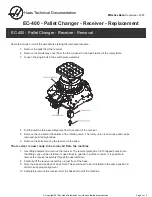
E-40 SETTING OF COORDINATE SYSTEM
9
OPERATION PROCEDURE OF MANUAL IN-MACHINE TOOL
PRESETTER
This section describes the procedure used for setting the tool geometry offset and Z-axis work
shift offset data by using the manual in-machine tool presetter.
9-1
Interlocks for Using the Manual In-machine Tool Presetter
The manual in-machine tool presetter function is provided with following interlocks.
1.
If the GEOMETRY OFFSET screen is not displayed even if the presetter mode switch
is
pressed after the installation of presetter arm, check the following items if they are satisfied.
The X- and Z-axes of both the turret 1 and turret 2 are returned to the zero point.
Both the turret 1 and turret 2 are indexed to the correct position.
A manual mode (handle, jog, rapid traverse, zero return) is selected.
The tailstock is clamped.
The protection cover is mounted to the presetter base of the turret side on which the
presetter is not used and the locking lever is not tightened if the protection cover is not
mounted to the presetter base.
2.
Axis movement is precluded unless the presetter mode switch
is turned ON after the
installation of presetter arm.
3.
Cover close state is checked from the installation of the protection cover to the base. When
the locking lever is turned to the clamp side, the cover close state is detected. If the cover
close check signal is turned off, the operation is suspended in the following manner.
<Manual mode>
Spindle rotation and coolant supply are stopped.
<Automatic mode>
Alarm message is displayed and automatic operation is suspended. Spindle rotation, axis
movement, and coolant supply are stopped.
4.
To prevent the interference with the presetter arm, the following operation is not allowed
when the presetter arm is installed.
Tailstock spindle IN/OUT and inching operation
Moving the tailstock body
Parts catcher operation (parts catcher specification)
Entry of robot arm into the machine (robot specification)
Entry of loader arm into the machine (loader specification)
5.
Axis movement stops if the cutting tool comes into contact with the stylus; after axis
movement is stopped, the axis can only be moved in the direction in which the cutting tool is
moved away from the stylus.








































